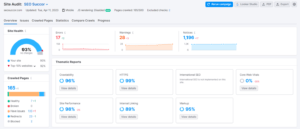HTML (HyperText Markup Language) is a foundational element of virtually all websites. As well as providing structure to a webpage, it also plays a crucial role in helping search engines understand your content. One such aspect of HTML structure involves the use of heading tags.
Understanding the semantic structure of HTML tags, especially for subheadings, is critical in creating clear, accessible, and SEO-friendly web content.
Oftentimes I see clients using subheading to style their web content, as their theme will have different CSS values for each subheading option. This is an incorrect use. You do not want to use subheading only to style your text.
Heading tags, from <h1> to <h6>, are used to define the structure and hierarchy of a webpage’s content. Understanding how to use these tags in the correct order, known as semantic order, is important both for accessibility and for technical SEO.

Technical SEO refers to the process of optimizing your website for the crawling and indexing phase. It’s called “technical” because it has nothing to do with the actual content of the website or with website promotion. The main goal of technical SEO is to optimize the infrastructure of a website.
Let’s dig into how you can utilize these subheadings in the proper semantic order, in order to add technical SEO value to your website.
Semantic order refers to the way in which HTML elements are organized to convey meaning and hierarchy. By structuring your content using appropriate HTML elements, you help search engines and accessibility tools understand the flow of your content.
HTML provides six levels of headings, <h1> through <h6>. The <h1> tag is meant to represent the most important heading, and the other tags should be used in descending order of importance.
<h1>Main Heading</h1>
<h2>Subheading</h2>
<h3>Sub-Subheading</h3>
<h2>Another Subheading</h2>
<h3>Another Sub-Subheading</h3>
<h4>Even More Specific Subheading</h4>
<h1>Another Main Heading</h1>
The correct use of heading tags should be in a descending order, starting from <h1> and going down to <h6>. As seen in the above example, it’s perfectly okay to have multiple <h1> tags, as long as each represents a distinct section of your content.
If heading tags are used out of order, it can confuse search engines and accessibility tools. For example:
<h1>Main Heading</h1>
<h4>Subheading</h4>
<h2>Another Subheading</h2>
<h3>Another Main Heading</h3>
In the above example, the subheadings are not in correct order. The first subheading jumps from <h1> to <h4>, skipping <h2> and <h3>. Similarly, the second main heading should be <h1>, not <h3>. It disrupts the logical hierarchy of the content, and it’s not a good practice.
Using HTML headings in the proper semantic order isn’t just about search engine optimization – it’s also a crucial aspect of web accessibility. By using headings correctly, you’ll ensure that your content is structured logically and is easy to navigate, not just for search engines but also for all users.
Remember, a correctly structured HTML document improves the user experience and accessibility while potentially boosting your search engine visibility.
Search Engine Optimization (SEO) is a crucial component of digital marketing, and technical SEO is a vital part of any SEO strategy. A technical SEO audit is an evaluation of the technical aspects of a website to identify issues that may be limiting the crawlers or users from accessing the site.
Technical SEO issues can cause problems including but not limited to: pages to not be indexed, pages to load slow, or poor UX.
In order to conduct a full technical audit, you will need to interpret the data afterwards, and review the URLs manually to examine their content. This is because crawlers can only point out so much, the human is still required to interpret many of the best possible improvements, and also to decide what, if any, false positives were identified.
Let’s explore some of the most important components of a technical SEO audit and why it is essential for businesses to conduct regular SEO audits. But first, it is important to point out that just crawling your website isn’t really going to be enough.

A technical SEO audit examines a website’s structure and hierarchy to ensure it is well-organized and easy for search engines to crawl. Site architecture can have a significant impact on a website’s ranking, so it is essential to ensure that it is optimized for search engines.
Site speed is an essential ranking factor for search engines. Today, the gold standard of page speed measurement comes from Google’s Core Web Vitals. A technical SEO audit examines a website’s speed to identify any issues that may be slowing it down. This includes examining file sizes, page load times, and server response times.
Mobile optimization is becoming increasingly important as more people use their mobile devices to browse the web. A technical SEO audit examines a website’s mobile optimization to ensure that it is optimized for mobile devices.
Duplicate content can hurt a website’s visibility in SERP. A technical audit examines a website’s content to identify any duplicate content issues. This includes examining meta descriptions, title tags, and URLs.
URLs play a crucial role in SEO. A technical SEO audit examines a website’s URLs to ensure that they are descriptive, easy to read, and contain relevant keywords. Additionally, URLs are examined for underscores, spaces, or special characters, as these are not recommended when creating search engine optimized URLs.
Redirects are an essential tool that allow webmasters to redirect users from one URL to another URL. A technical SEO audit examines a website’s redirects to ensure that they are properly implemented and not causing any issues for search engines, such as squandering crawl budget.
Both 301 and 302 redirects count as a resource towards a site’s crawl budget, so really, each redirect represents an additional resource that could have been crawled any given day. This is why site owners should work to eliminate redirected URLs from a website’s copy.
Because the robots.txt offers suggestions to search engines about which pages they should or should not crawl, it is a component of SEO. A technical SEO audit examines a website’s robots.txt file to ensure that it is properly configured. However, it is important to note that robots.txt files are only treated as suggestions, if you want to ensure that Google doesn’t crawl a page you are better served using the robots meta tag.
Unlike the robots.txt file, which is hosted on the root of the website as /robots.txt, robots meta tags live individually on any given page of HTML. This means they need be updated on a page-by-page basis.
Technical SEO audits are important for many reasons, but their primary purpose is to find reasons that would prevent search engine spiders (crawlers) from indexing a website in SERP. Fantastically enough, repairing issues identified in technical audits can also improve a website’s visibility in SERP! So its always a good idea to review your technical audits, so as to not let any easy SEO wins or potential harm, slip by unnoticed.
SEO audits identify technical issues that may be hurting a website’s ranking on search engines. By identifying and fixing these issues, such 404 errors, for example, a website can improve its search engine rankings and attract more traffic.
With improved rankings for target keywords, comes improved relevant traffic. By so conducting regular audits and fixing technical issues, businesses ultimately can attract more traffic to their website.
A technical SEO audit examines a website’s user experience to ensure that it is easy to navigate and provides value to visitors. By improving the user experience, businesses can keep visitors engaged longer (often creating better conversion rates).
Regular tech audits help businesses stay ahead of their competitors by identifying and fixing technical issues before they become a problem, causing them to fall behind competitors in SERP .
For these reasons technical SEO audits are an essential component of any SEO strategy. By examining a website’s architecture, site speed, mobile optimization, duplicate content, URLs, redirects, and robots.txt file, businesses can identify and fix technical issues that may be hurting their search engine rankings.
You should crawl your website for errors anytime new code or content is pushed live. However, you can also schedule regular crawls with certain tools. Regular technical crawls help businesses ensure that the technical SEO of their website has not worsened.
Popular tools are available to automate technical crawls, such as SEMrush or Ahrefs.
However, for a more thorough crawl we recommend configuring Screaming Frog to meet your needs.
If you are interested in scheduling a full technical audit of your website, reach out for a free initial consultation or contact us.
We can ensure total technical optimization, or package up the audit for your team to take care of the fixes.
We are digital marketing consultants, full-stack web developers, and expert SEOs. Check out our case studies, view our previous web dev work, and read our client reviews to learn more about us.